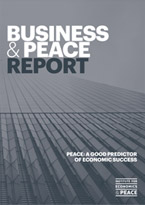 Institute for Economics & Peace
Institute for Economics & Peace
Overview: This report analyses the relationship between the economic performance of a country and its levels of peace. The major finding of this report is that peace acts as a good predictor of a country’s future performance in a number of macroeconomic indicators. These insights can be used to better assess the expected investment potential of countries.
Rather than asking what businesses can do for peace, the study differentiates itself from other work by focusing on what peace can offer businesses. Institute for Economics & Peace (IEP) sees this as an important but missing step in business analysis. In order for businesses to be an actor in building peace, investors first need to see the benefits of peace to their investment decisions.
The results of this work show that economic performance can be predicted by understanding the movement in the same socio-economic factors that affect peacefulness. These conditions are known as Positive Peace. The countries that improved the most in Positive Peace between 2010 and 2016 also had substantially above average economic performance.
Five macroeconomic indicators were analysed through two different measures of peace: the Global Peace Index (GPI), which measures the absence of violence or fear of violence, and the Positive Peace Index (PPI), which measures the
attitudes, institutions and structures that create and sustain peaceful societies. IEP’s research has found that measures of Positive Peace are a good indicator of future levels of peace and of macroeconomic performance.
Countries who currently have low levels of violence or fear of violence, as measured by the GPI, over the last six decades have averaged 3 times the gross domestic product (GDP) growth rates of countries ranked at the bottom of the GPI over the same period. Similarly, countries that perform well on the GPI have lower inflation rates, easier access to financing, and higher rates of foreign direct investment (FDI). However, defining peace solely by levels of violence does not provide a complete picture of the future prospects for peace and business. Changes in Positive Peace are a more accurate measure of future prospects.
Changes in Positive Peace are associated with changes in a number of macroeconomic indicators – GDP growth, FDI and credit ratings. Because it measures the background socioeconomic conditions that creates the environment for both peace and business to flourish, changes in Positive Peace are lead indicators for future changes in both peace and the business environment. Between 2005 and 2016, countries that were improving in Positive Peace had on average 2 per cent per annum higher GDP growth rates than countries deteriorating in Positive Peace.
